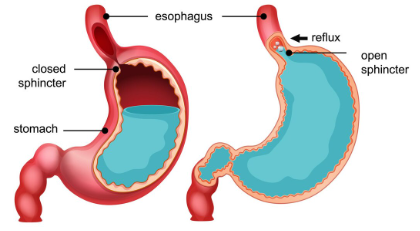Gastroesophageal reflux disease is a condition in which the stomach acid backflow into the esophagus (food pipe), leading to heartburn symptoms. Approximately fifty percent of the individuals experience gastroesophageal reflux disease (GERD) symptoms regularly.
How Does Posture Affect Your GERD Symptoms?
Although lifestyle factors such as eating habits, stress, overweight, and alcohol and tobacco are all huge contributors to GERD, one other factor is posture, which most GERD patients usually do not consider. Any posture that causes excessive abdominal pressure can increase stomach acid reflux. The posture can affect your GERD symptoms in the following two ways:
Poor Sitting Posture
The poor sitting posture or hunching posture creates extra pressure on the vital organs leading to disruption of their normal functions. GERD symptoms occur when the digestion process is disturbed. This occurs when the lower esophageal sphincter (LES) valve becomes relaxed, causing the backflow of stomach acid into the esophagus, which causes heartburning and indigestion. If you are sitting in a hunching posture, this can disrupt the normal function of the organs present in the digestive tract. Normally, the food content mixed with digestive juices flows from the stomach to the intestines. Sitting in an improper or distorted position disrupts the normal flow of food and creates pressure on the LES valve. As a result, the LES valve gets opened and increases the acid’s chances of backflow into the esophagus, leading to a burning sensation.
Standing in a Slouching Position
Standing in a slouching position after a meal may lead to twisting your esophagus and block your chest and stomach, leading to symptoms like shortness of breath, discomfort, and heartburn. Blockage and congestion in the stomach may restrict your burp, which in turn creates pressure on your abdomen. All this ultimately results in the development of your GERD symptoms.
Sleeping Positions
Sleeping or lying towards the right side of your body leads to the opening of the LES valve. The valve remains relaxed and is unable to close. As a result, the LES muscles get tired, due to which the acidic contents within the stomach backflow into the esophagus.
Postures That Can Improve Your GERD Symptoms
Before improving your postures for getting relief from your GERD symptoms, you should understand if postures are responsible for your GERD or not. To know about the role of posture in your GERD, you can try a 30-minute posture challenge. After having a meal, sit straight without resting your back against the chair. Sit in a position that your shoulders and back are straight without any support on the chair. If you cannot sit in such a position for almost half an hour, there are chances that your GERD is due to distortion in your postural patterns. In that case, you should try to correct your posture patterns to get relief from your GERD symptoms.
Following are some of the postural positions that can be helpful while dealing with your GERD symptoms:
Standing Straight
Standing straight position helps your esophagus be perpendicular to the ground, thereby allowing the LES valve to normally perform its function, preventing the backflow of stomach acidic contents from coming into the esophagus. Following tips can help you in maintaining a proper standing posture:
- Standing on your feet with shoulders wide apart.
- Keeping your head directly above your spine.
- Pulling your shoulders back and down.
- Keeping your solar plexus (a complex of ganglia and nerves present in the pit of the stomach) perpendicular to the floor.
Sitting Upright
Sitting upright position reduces pressure on the LES and allows the esophagus to be perpendicular to the ground. This helps in reducing the chances of appearing GERD symptoms. You can maintain proper sitting posture by:
- Sitting with your shoulder back and down.
- You should keep your scapula pinched together.
- You should be very conscious about correcting yourself if you begin leaning forward and resting against the chair.
- You can keep your feet flat on the floor.
- Avoid shifting to one side of your chair.
Sleeping Position
If you have GERD symptoms, consider sleeping on your left side. Sleeping on the left side keeps the LES valve closed and prevents the backflow of acidic contents within the stomach into the esophagus. Besides, you can elevate the head of the bed by 10-15 degrees. This helps in maintaining the gravity during sleeping and therefore prevents the backflow of food into the esophagus.
Strengthening Exercises to Maintain Correct Posture for Reducing GERD
Some strengthening exercises have been found to be extremely useful in maintaining postures that are helpful for GERD. However, if you find difficulty in maintaining these postures, you can consult your physical therapist. Your therapist may improve your posture by recommending certain specific exercises for muscles that control your posture. Some of these recommended exercises include:
Stretching Exercises
Cobra
The cobra is a good stretching exercise that helps stretch your abdominal muscles connected to the digestive cavity. This exercise can be performed as follows:
- Lie on your stomach on a solid surface
- Place your palms in such a position that they push your chest up facing forward.
- Keep your elbows close to your body and push your shoulders up to the floor for enough flexibility.
- Perform this stretching exercise regularly as long as you can do it. Besides, try to focus on deep breathing while holding the stretch.
Hanging Stretch
Hanging stretch exercises allow flexibility of the entire back, loosening, and strengthening of abdominal muscles. This exercise also helps in the alignment of the spine and chest cavity. Sitting in a wrong posture can cause a part of the stomach to slide upwards through the diaphragm opening, due to which the LES valve can’t close properly. Due to improper closure of the LES valve, As a result, the acidic contents in the stomach flow back into the esophagus (acid reflux).
Stretching exercise can be performed by stretching one arm up to a ledge or bar and allowing your body to hang loosely and then stretch. You can repeat this process several times a day to encourage portions of the stomach to slide back to their normal positions in the abdominal cavity and to improve proper posture.
Deep Breathing Exercises
Most people suffer from breathing problems, which can cause issues with posture regarding the digestion process. Deep breathing exercise can be performed as follows:
- Place one hand on your chest and the other hand on your stomach.
- Deeply breathe through your nose with the help of a diaphragm.
- During inhalation, ensure that the hand on your stomach should go upwards while the hand on your chest should remain at the same position.
- Exhale deeply through your nose, allowing your stomach muscles to tighten while keeping the hand on the chest still.






